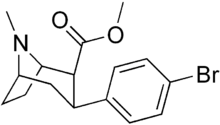RTI-51
(–)-2β-Carbomethoxy-3β-(4-bromophenyl)tropane (RTI-4229-51, bromopane) is a semi-synthetic alkaloid in the phenyltropane group of psychostimulant compounds. First publicized in the 1990s, it has not been used enough to have gained a fully established profile. RTI-51 can be expected to have properties lying somewhere in between RTI-31 and RTI-55. Importantly it has a ratio of monoamine reuptake inhibition of D > S > N (1.8:10.6:37.4nM respectively) which is an unusual balance of effects not produced by other commonly used compounds (although RTI-121 is similar, but more DAT selective).[1] It has been used in its 76Br radiolabelled form to map the distribution of dopamine transporters in the brain.[2]
| Halogen | Atomic № | Atomic Weight | EN | Bond Length |
| Fluorine | 9 | 19.0 | 4.0 | |
| Chlorine | 17 | 35.5 | 3.2 | |
| Bromine | 35 | 79.9 | 3.0 | |
| Iodine | 53 | 127 | 2.7 | |
 | |
| Identifiers | |
|---|---|
| |
| CAS Number | |
| PubChem CID | |
| CompTox Dashboard (EPA) | |
| Chemical and physical data | |
| Formula | C16H20BrNO2 |
| Molar mass | 338.245 g·mol−1 |
| 3D model (JSmol) | |
| |
| |
| | |
Modern research seems to confirm the above hypothesis.[3] However, earlier work produced more scattered results.[4] Based upon what is obvious from the table, RTI-31, RTI-51, and RTI-55 are all similarly potent TRIs.[5][6]
| MAT IC50 (and Ki) for simple phenyltropanes with 1R,2S,3S stereochemistry.[7] | ||||||
| Compound | [3H]CFT | [3H]DA | [3H]Nisoxetine | [3H]NE | [3H]Paroxetine | [3H]5-HT |
| Cocaine[8] | 89.1 | 275 cf. 241 | 3300 (1990) | 119 cf. 161 | 1050 (45) | 177 cf. 112 |
| WIN 35,065-2 | 23 | 49.8 | 920 (550) | 37.2 | 1960 (178) | 173 |
| WIN 35,428 | 13.9 | 23.0 | 835 (503) | 38.6 | 692 (63) | 101 |
| RTI-31 | 1.1 | 3.68 | 37 (22) | 5.86 | 44.5 (4.0) | 5.00 |
| RTI-113[9] | 1.98 | 5.25 | 2,926 | 242 | 2,340 | 391 |
| RTI-51 | 1.7 | ? | 37.4 (23) | ? | 10.6 (0.96) | ? |
| RTI-55 | 1.3 | 1.96 | 36 (22) | 7.51 | 4.21 (0.38) | 1.74 |
| RTI-32 | 1.7 | 7.02 | 60 (36) | 8.42 | 240 (23) | 19.4 |
Data in Above table from rats brains (1995). More recent work has advocated using cloned human transporter/s.
See also
References
- Singh S (March 2000). "Chemistry, design, and structure-activity relationship of cocaine antagonists". Chemical Reviews. 100 (3): 925–1024. doi:10.1021/cr9700538. PMID 11749256.
- Loch C, Müller L, Ottaviani M, Halldin C, Farde L, Maziere B. Synthesis of 2β-carbomethoxy-3β-(4-[76Br]bromophenyl)tropane ([76Br]β-CBT), a PET tracer for in vivo imaging of the dopamine uptake sites. Journal of labelled compounds & radiopharmaceuticals. 1995; 36(4):385-392.
- Wee S, Carroll FI, Woolverton WL (February 2006). "A reduced rate of in vivo dopamine transporter binding is associated with lower relative reinforcing efficacy of stimulants". Neuropsychopharmacology. 31 (2): 351–62. doi:10.1038/sj.npp.1300795. PMID 15957006.
- Stathis M, Scheffel U, Lever SZ, Boja JW, Carroll FI, Kuhar MJ (June 1995). "Rate of binding of various inhibitors at the dopamine transporter in vivo". Psychopharmacology. 119 (4): 376–84. doi:10.1007/BF02245852. PMID 7480516.
- Kimmel HL, Carroll FI, Kuhar MJ (December 2001). "Locomotor stimulant effects of novel phenyltropanes in the mouse". Drug and Alcohol Dependence. 65 (1): 25–36. doi:10.1016/S0376-8716(01)00144-2. PMID 11714587.
- Kuhar MJ, Carroll FI, Bharat N, Landry DW (August 2001). "Anticocaine catalytic antibodies have no affinity for RTI compounds: implications for treatment". Synapse. 41 (2): 176–8. doi:10.1002/syn.1072. PMID 11400184.
- Carroll FI, Kotian P, Dehghani A, Gray JL, Kuzemko MA, Parham KA, et al. (January 1995). "Cocaine and 3 beta-(4'-substituted phenyl)tropane-2 beta-carboxylic acid ester and amide analogues. New high-affinity and selective compounds for the dopamine transporter". Journal of Medicinal Chemistry. 38 (2): 379–88. doi:10.1021/jm00002a020. PMID 7830281.
- Kozikowski AP, Johnson KM, Deschaux O, Bandyopadhyay BC, Araldi GL, Carmona G, et al. (April 2003). "Mixed cocaine agonist/antagonist properties of (+)-methyl 4beta-(4-chlorophenyl)-1-methylpiperidine-3alpha-carboxylate, a piperidine-based analog of cocaine". The Journal of Pharmacology and Experimental Therapeutics. 305 (1): 143–50. doi:10.1124/jpet.102.046318. PMID 12649362.
- Damaj MI, Slemmer JE, Carroll FI, Martin BR (June 1999). "Pharmacological characterization of nicotine's interaction with cocaine and cocaine analogs". The Journal of Pharmacology and Experimental Therapeutics. 289 (3): 1229–36. PMID 10336510.